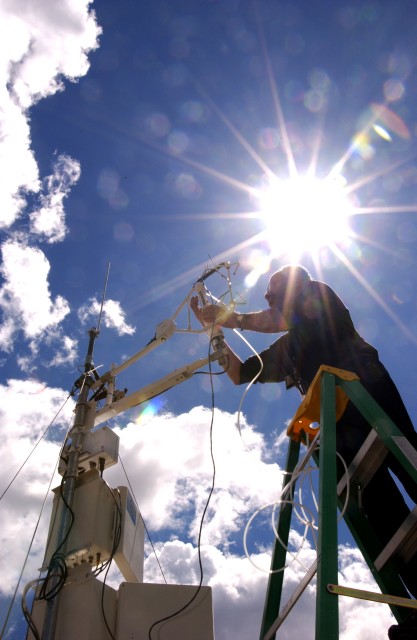According to Manvendra Dubey, the lead Los Alamos scientist on the Valles Caldera AmeriFlux team, "there is roughly 7 gigatons of carbon produced annually in the world from the burning of fossil fuels. Of that amount, approximately one quarter is taken up in the carbon cycle by forests and grasslands. Grasslands are probably the least understood part of the global carbon cycle and are often managed by default. Obviously, a better understanding of the role of grasslands in the carbon exchange cycle could lead to grassland management practices that enhance this important environmental function."
The VCNP site is a region of montane grasslands that have previously been used for cattle and elk grazing. Currently fenced off to prevent elk and cattle grazing, the study area is the site of a 20-foot-tall tower with instruments for recording carbon dioxide concentrations, solar radiation, and eddy flux wind velocities on a once per second basis. Subsurface measurements are also being taken of soil moisture, soil carbon and soil nitrogen. Data is being gathered for comparison against future studies that will permit cattle and elk grazing on the study site.
The team is planning to install a high-resolution spectrometer on the tower in order to compare spectrographic data against satellite images of grass color in order to better understand the possible relationships between the two data sources.
The Valles Caldera AmeriFlux team has a proposal to NASA under review that would add spectrometers to the site in order to facilitate the development of remote sensing tools for scaling results to regional scales, and making the Valles Caldera site better suited as a possible test-bed for NASA's Orbiting Carbon Observatory that is scheduled to launch in 2007.
The AmeriFlux project was organized by the Department of Energy's Office of Basic Energy Research. The goal of the AmeriFlux Project is to take direct and long-term measurements of carbon dioxide and water vapor fluxes between terrestrial ecosystems and the atmosphere in order to better understand the global carbon cycle. The Valles Caldera site is the only New Mexico site in the AmeriFlux network.
In addition to funding from the Department of Energy's Office of Basic Energy Research, the Los Alamos AmeriFlux research is supported by funding from the Laboratory-Directed Research and Development (LDRD) program, the University of California's Institute of Geophysics and Planetary Physics (IGPP) and Laboratory postdoctoral programs.
Besides Dubey, the Valles Caldera AmeriFlux team also includes Thomas Rahn, Julianna Fessenden-Rahn and Nate McDowell of the Laboratory's Earth and Environmental Sciences Division, Chris Jeffery and Chris Borel of the International, Space and Response Division, Robert Parmenter of VCNP and William Parton of Colorado State University at Fort Collins, Colo.
Los Alamos National Laboratory, a multidisciplinary research institution engaged in strategic science on behalf of national security, is operated by Los Alamos National Security, LLC, a team composed of Bechtel National, the University of California, The Babcock & Wilcox Company, and Washington Group International for the Department of Energy's National Nuclear Security Administration.
Los Alamos enhances national security by ensuring the safety and reliability of the U.S. nuclear stockpile, developing technologies to reduce threats from weapons of mass destruction, and solving problems related to energy, environment, infrastructure, health, and global security concerns.

